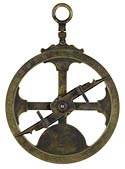
Astrolabe c.16th -17th century
The Folger Shakespeare Library in Washington, DC has been hosting an intriguing exhibit: Lost at Sea – The Ocean in the English Imagination, 1550-1750. Unfortunately the exhibit itself is almost over, running only through September 4th. Nevertheless, for those of us who cannot make it to Washington, the exhibit website itself is fascinating.
The NY Times recently published a review of the exhibit:
The Sea and the English Who Tried to Master It.
There is probably nothing in contemporary life comparable to the role the ocean played in that period. The curator, Steve Mentz, who teaches English at St. John’s University in New York, has a keen interest in Shakespeare’s images of the sea — something that is particularly helpful for the larger vision he outlines.
At the beginning of the 17th century, the ocean was scarcely understood and riskily charted. It was also the medium for the exercise of international power, the site of exploratory fantasy and the terrain over which Divine Providence exacted mysterious judgments. All strands of human knowledge and experience were associated with the ocean. “Technological know-how and cartographic knowledge were essential,” the exhibition tells us, “but so also were narrative understanding and religious faith.”
This was particularly true for England, an island nation that could thrive only through mastery of the sea. Many of the 16th-century English books here are translations of volumes from more established seafaring cultures. A 1596 copy of Martín Cortés’s “Arte of Navigation” translated the Spanish reference book into English and provided a model for others. “The Mariners Mirrour” (around 1588) “transformed” a Dutch atlas, but also staked a new claim in its hand-colored frontispiece, which optimistically placed the English nation at the glorious center of the maritime world.
